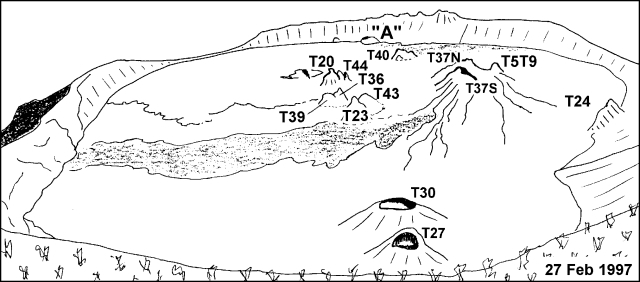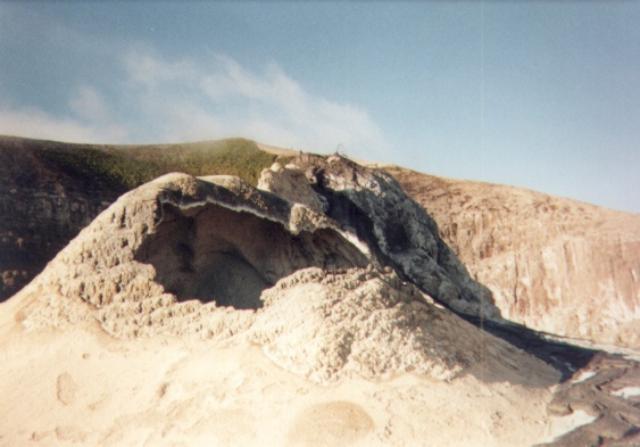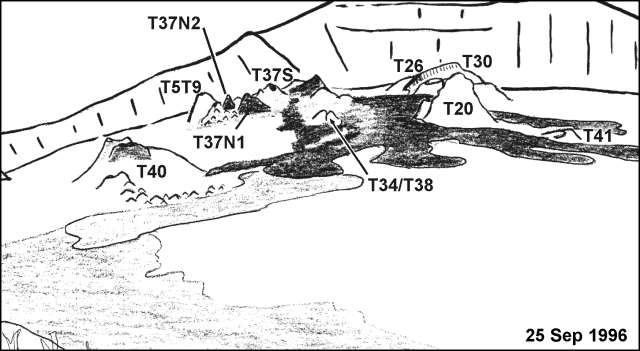Report on Ol Doinyo Lengai (Tanzania) — June 1998
Bulletin of the Global Volcanism Network, vol. 23, no. 6 (June 1998)
Managing Editor: Richard Wunderman.
Ol Doinyo Lengai (Tanzania) Changes in crater morphology since September 1996
Please cite this report as:
Global Volcanism Program, 1998. Report on Ol Doinyo Lengai (Tanzania) (Wunderman, R., ed.). Bulletin of the Global Volcanism Network, 23:6. Smithsonian Institution. https://doi.org/10.5479/si.GVP.BGVN199806-222120
Ol Doinyo Lengai
Tanzania
2.764°S, 35.914°E; summit elev. 2962 m
All times are local (unless otherwise noted)
The following outlines changes in the crater of Ol Doinyo Lengai from September 1996 to February 1998. Much of the information is based on reports and photographs provided to Celia Nyamweru by local mountain guide Burra Ami Gadiye, except where otherwise noted.
Summary. Continuing eruptive activity during this period was centered mostly near the E side of the crater. Little change occurred in the S of the crater. As multiple new cones emerged from and obscured older cones, clusters of cones arose and eventually merged into larger clusters. Numerous thin lava flows had raised the level of the crater floor by several meters, but did not overflow the crater wall. Several reports throughout the period mentioned that lava was observed flowing or bubbling, and that steam and gas were being emitted from vents on the crater floor, walls, and rim. Lava was also erupted at other times as evidenced by continued changes in crater morphology.
General appearance. Two photographs taken 8 November 1996 showed very fluid lava emerging at the end of a small pahoehoe flow close to the N crater wall. The level of lava had risen along this wall and began to cover the cone cluster designated "A" (figure 48), which had been visible since the mid-1980's. A circular depression NW of the T20/T44 cluster, first observed in February 1997, had been partly filled by September 1997 with lava from sources farther to the E, but was not thought to be a source of lava.
 |
Figure 48. A view of the crater of Ol Doinyo Lengai looking N from the crater rim on 27 February 1997. Sketch by C. Nyamweru from a photo by B.A. Gadiye. |
By 6 June 1997 several significant new cones, including T40B and T5T9C, had been added to existing clusters. Lava had flowed from several sources including a vent on the T40 cluster. Smaller flows on the N slope of T37N probably originated, at roughly the same date, from a source low on the W slope of T37N. By 17 June a new cone (now designated T44C) had formed on the SE side of the T20/T44 cluster.
Josh Lane reported in February 1998 that no fluid lava was visible on the crater floor. Steam from a vent on the E crater rim was visible from the base of the cone, and sulfur crystals in cracks along with sulfur fumes were observed on the E side of the crater. The crater floor ranged in color from white to pale gray and chestnut brown; weathered lava was visible including the outlines of old flows with irregular surfaces. Green vegetation was apparent on the E crater wall up to the rim, a few meters above the crater floor, but the slopes below the rim were bare and dark. Toward the SE of the crater, the wall and rim were black to a line beyond which was healthy green vegetation. A similar contrast in color was visible in earlier photos. Cone T26 (figure 49) at the base of the south wall had changed little from prior observations. The smoothness of the crater floor, pale brown to white in color, extended to the SW rim. Green, unscorched and undisturbed vegetation covered the SW wall from top to bottom revealing no sign that ash had been deposited in previous months.
T20/T44 cluster. Photographs taken on 8 February 1997 revealed a new feature which is now called T44. It is a tall, dark, narrow cone adjacent to T20. Photographs taken a week later showed a shallow circular depression bounded by curved cracks in the crater floor to the NW of T20. Tim White, a St. Lawrence University student, reported fumes, heat, and rumbling from several vents including T39 and the T20/T44 cluster on 25 February 1997. New cones were observed S of T45 in the area of T20/T44 during the visit of Josh Lane on 23 February 1998.
Crater center and T23. No liquid lava was observed in photos taken on 29 January 1997, but there had been activity since November 1996 as indicated by the formation of a new cone near the center of the crater (T43, figures 48 and 50). On 28 June 1997 lava was observed erupting from the top of T23. T43 was inactive at this time. Liquid or very recently cooled lava was visible on 6 July that had originated from a vent on the T40 cluster and flowed N and W. Several new cones were seen on 23 February 1998 in the approximate area of T36, T39, and T23. One of these new cones (T47) was broad and darkly colored. Behind it was a very deep cone towards the SW end of the cluster, close to T23.
 |
Figure 50. Cone T43 in the crater of Ol Doinyo Lengai looking SW on 28 June 1997; cone T23 is in the immediate background. Courtesy of C. Nyamweru; photo by B.A. Gadiye. |
T37 complex. The cone cluster T37 has increased in size and complexity. A broad massive peak towards the south of the cluster (called T37S) and several northern cones (T37N1, T37N2) began to dominate the long-standing T5T9 cone by 25 September 1996. Several tongues of lava had been emitted from vents on the W slope of T37, and had flowed W and NW around the older cones. A large dark brown lava flow originating from the SW slope of T37S had flowed to the base of the W wall by February 1997.
Activity was observed again on 23 September 1997 with "flowing lava, lava bubbling from a vent, and sounds like ocean water flowing," as reported by Sommerleigh Baker of St. Lawrence University. Several narrow lobes of smooth pahoehoe extended NE from a vent close to T5T9C. The cones on the N wall appeared then to have been completely buried by younger lava. The NW wall, which had been the lowest part of the rim for several months, was still intact, standing 2-4 m above the crater floor. A tall, narrow cone, now numbered T37N3, had built up on the T37N cone. A photograph taken from the E rim on 23 September 1997 showed a moderately sized white to pale gray cone on the W of the crater, approximately where T42 had been located in November 1996. During the 23 February 1998 visit, sulfur fumes, steam, and heat were observed being emitted from several vents including T37N, T37S, T20/T44, T5T9, and T5T9C.
Geological Summary. The symmetrical Ol Doinyo Lengai is the only volcano known to have erupted carbonatite tephras and lavas in historical time. The prominent stratovolcano, known to the Maasai as "The Mountain of God," rises abruptly above the broad plain south of Lake Natron in the Gregory Rift Valley. The cone-building stage ended about 15,000 years ago and was followed by periodic ejection of natrocarbonatitic and nephelinite tephra during the Holocene. Historical eruptions have consisted of smaller tephra ejections and emission of numerous natrocarbonatitic lava flows on the floor of the summit crater and occasionally down the upper flanks. The depth and morphology of the northern crater have changed dramatically during the course of historical eruptions, ranging from steep crater walls about 200 m deep in the mid-20th century to shallow platforms mostly filling the crater. Long-term lava effusion in the summit crater beginning in 1983 had by the turn of the century mostly filled the northern crater; by late 1998 lava had begun overflowing the crater rim.
Information Contacts: Celia Nyamweru, Department of Anthropology, St. Lawrence University, Canton, NY 13617 USA (URL: http://blogs.stlawu.edu/lengai/).


